Faculty of Technology: Sustainable Development and Energy Essay
VerifiedAdded on 2022/08/23
|16
|3800
|34
Essay
AI Summary
This essay delves into the multifaceted concept of sustainable development, emphasizing the crucial link between environmental preservation, social well-being, and economic progress. It begins by defining sustainable development and outlining its core components and challenges, such as climate change, deforestation, and social inequalities. The discussion then pivots to specific sustainable development goals, including sustainable cities and communities, climate action, industry and innovation, good health and well-being, and affordable and clean energy. The essay provides an in-depth analysis of the transition to clean energy, exploring renewable resources, energy efficiency, and access to energy. The paper also examines the barriers to sustainable development, such as human behavior and government policies, and underscores the need for comprehensive strategies to overcome these obstacles. The paper highlights the importance of balancing present needs with future sustainability, advocating for responsible resource management and emission reduction. The essay concludes by summarizing key aspects of sustainable development and emphasizing the need for integrated approaches to achieve a sustainable future.
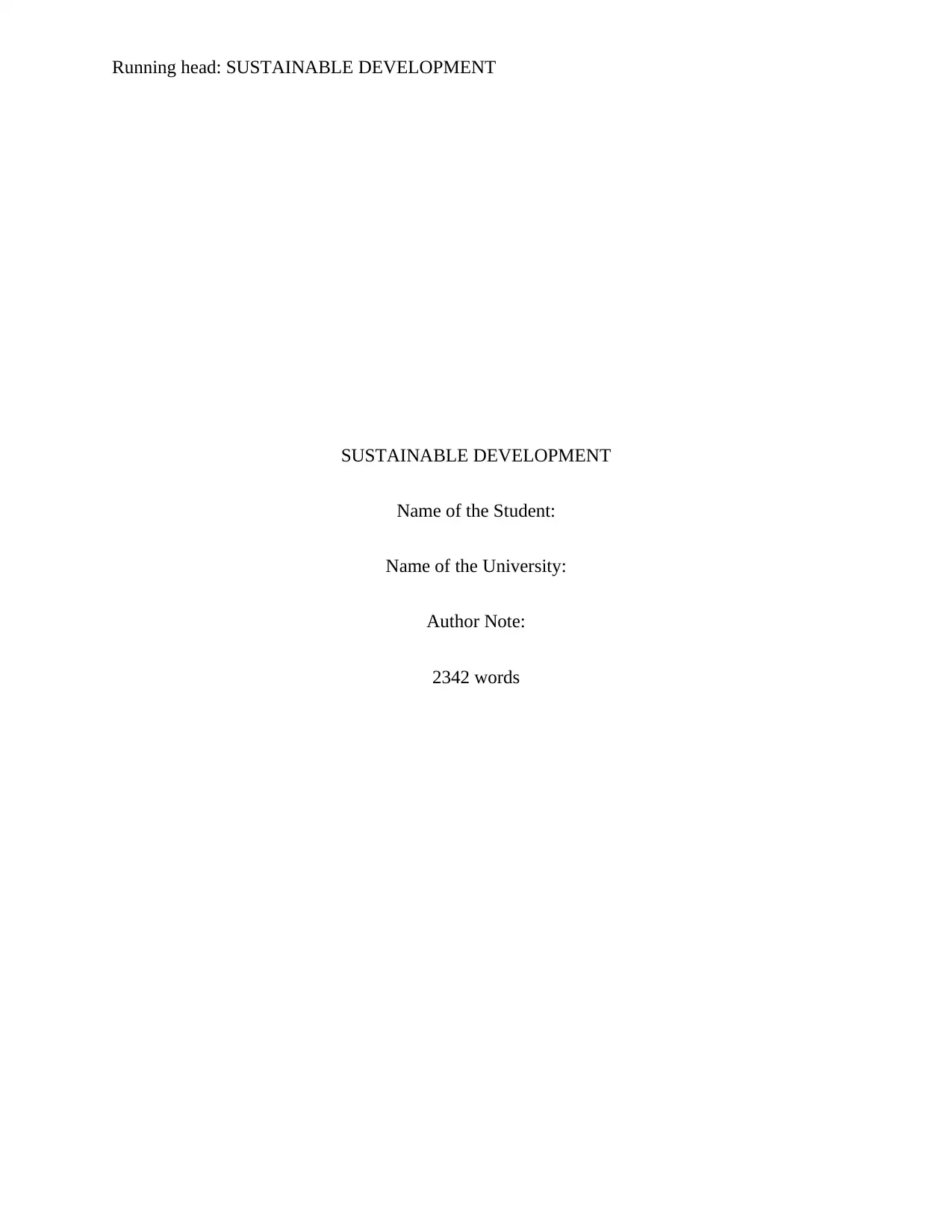
Running head: SUSTAINABLE DEVELOPMENT
SUSTAINABLE DEVELOPMENT
Name of the Student:
Name of the University:
Author Note:
2342 words
SUSTAINABLE DEVELOPMENT
Name of the Student:
Name of the University:
Author Note:
2342 words
Paraphrase This Document
Need a fresh take? Get an instant paraphrase of this document with our AI Paraphraser
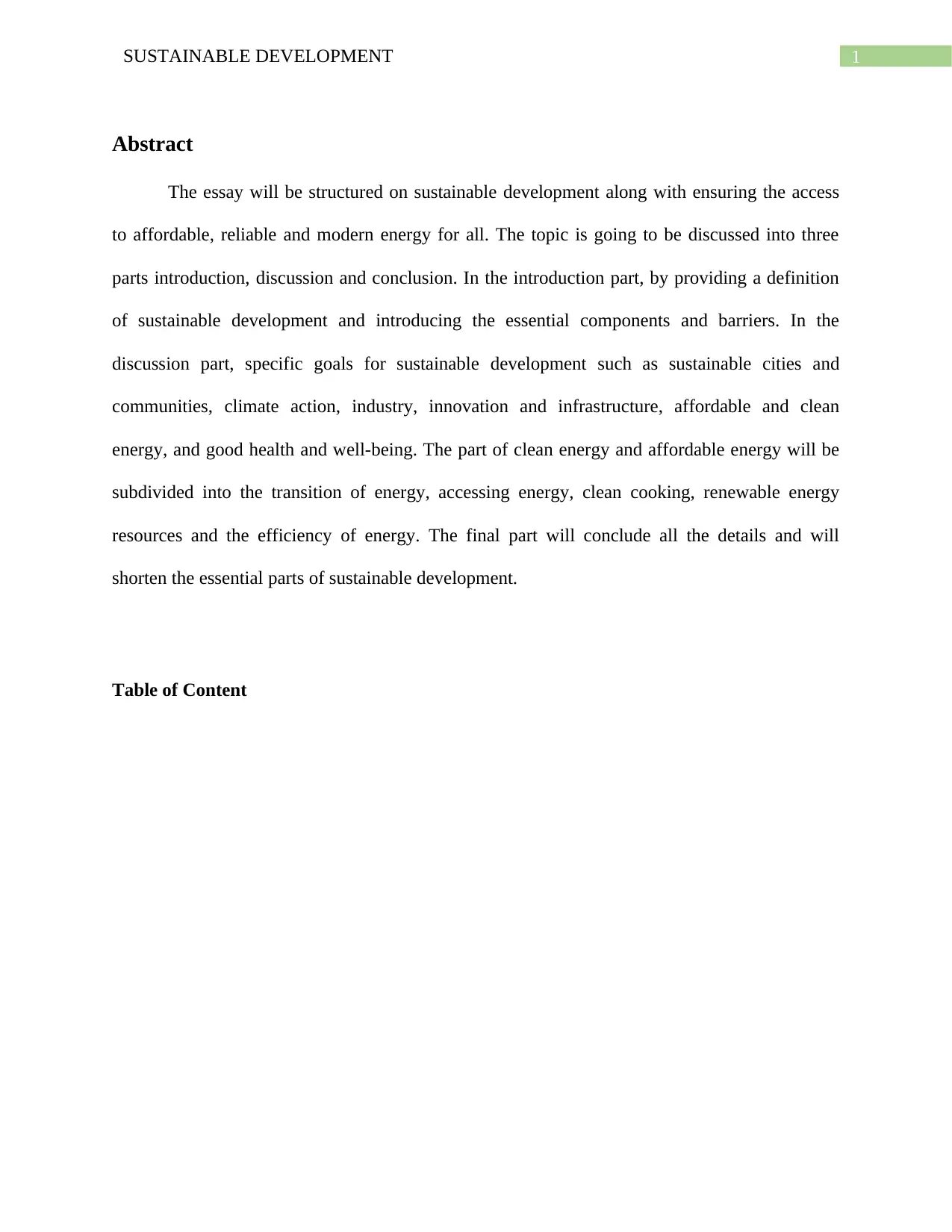
1SUSTAINABLE DEVELOPMENT
Abstract
The essay will be structured on sustainable development along with ensuring the access
to affordable, reliable and modern energy for all. The topic is going to be discussed into three
parts introduction, discussion and conclusion. In the introduction part, by providing a definition
of sustainable development and introducing the essential components and barriers. In the
discussion part, specific goals for sustainable development such as sustainable cities and
communities, climate action, industry, innovation and infrastructure, affordable and clean
energy, and good health and well-being. The part of clean energy and affordable energy will be
subdivided into the transition of energy, accessing energy, clean cooking, renewable energy
resources and the efficiency of energy. The final part will conclude all the details and will
shorten the essential parts of sustainable development.
Table of Content
Abstract
The essay will be structured on sustainable development along with ensuring the access
to affordable, reliable and modern energy for all. The topic is going to be discussed into three
parts introduction, discussion and conclusion. In the introduction part, by providing a definition
of sustainable development and introducing the essential components and barriers. In the
discussion part, specific goals for sustainable development such as sustainable cities and
communities, climate action, industry, innovation and infrastructure, affordable and clean
energy, and good health and well-being. The part of clean energy and affordable energy will be
subdivided into the transition of energy, accessing energy, clean cooking, renewable energy
resources and the efficiency of energy. The final part will conclude all the details and will
shorten the essential parts of sustainable development.
Table of Content
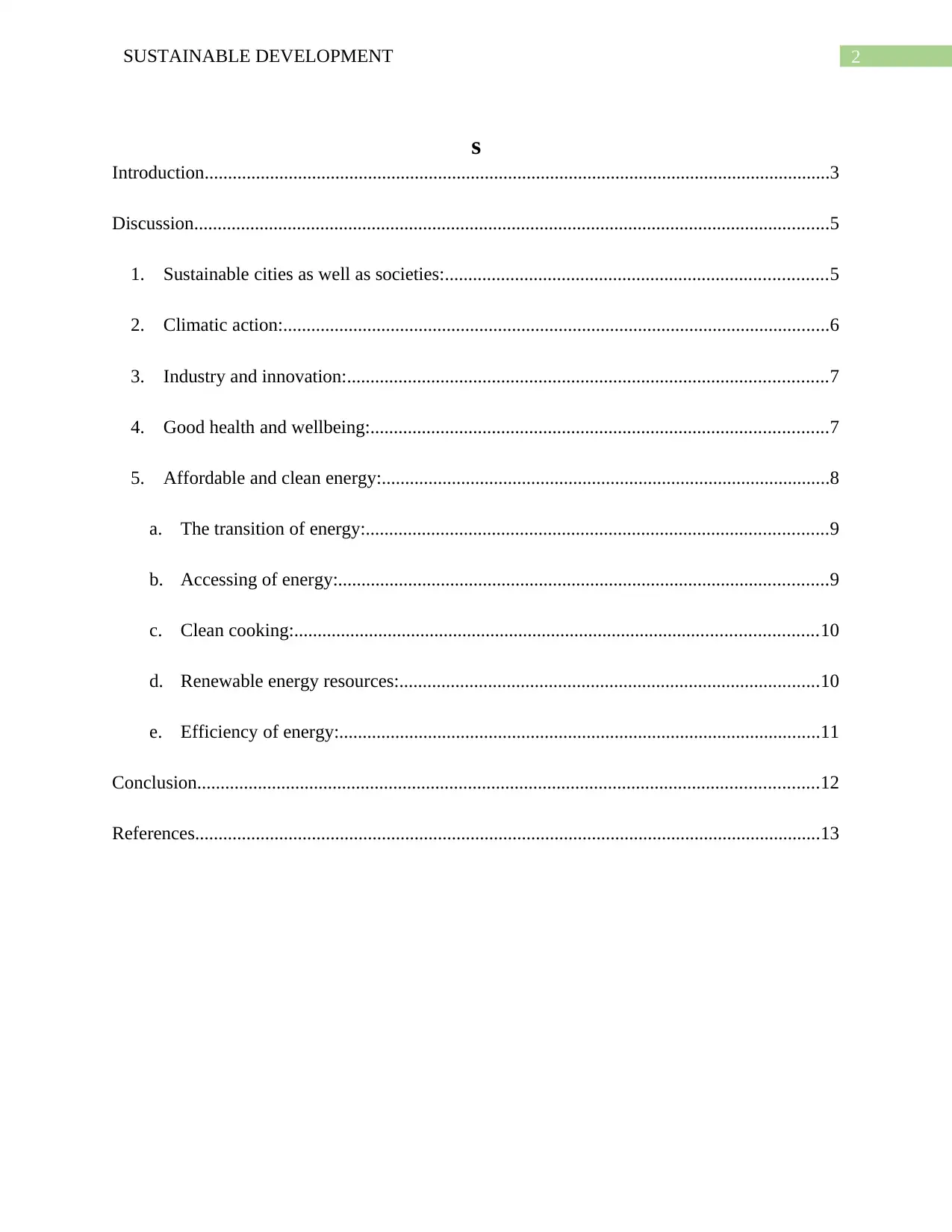
2SUSTAINABLE DEVELOPMENT
s
Introduction......................................................................................................................................3
Discussion........................................................................................................................................5
1. Sustainable cities as well as societies:..................................................................................5
2. Climatic action:.....................................................................................................................6
3. Industry and innovation:.......................................................................................................7
4. Good health and wellbeing:..................................................................................................7
5. Affordable and clean energy:................................................................................................8
a. The transition of energy:...................................................................................................9
b. Accessing of energy:.........................................................................................................9
c. Clean cooking:................................................................................................................10
d. Renewable energy resources:..........................................................................................10
e. Efficiency of energy:.......................................................................................................11
Conclusion.....................................................................................................................................12
References......................................................................................................................................13
s
Introduction......................................................................................................................................3
Discussion........................................................................................................................................5
1. Sustainable cities as well as societies:..................................................................................5
2. Climatic action:.....................................................................................................................6
3. Industry and innovation:.......................................................................................................7
4. Good health and wellbeing:..................................................................................................7
5. Affordable and clean energy:................................................................................................8
a. The transition of energy:...................................................................................................9
b. Accessing of energy:.........................................................................................................9
c. Clean cooking:................................................................................................................10
d. Renewable energy resources:..........................................................................................10
e. Efficiency of energy:.......................................................................................................11
Conclusion.....................................................................................................................................12
References......................................................................................................................................13
⊘ This is a preview!⊘
Do you want full access?
Subscribe today to unlock all pages.

Trusted by 1+ million students worldwide
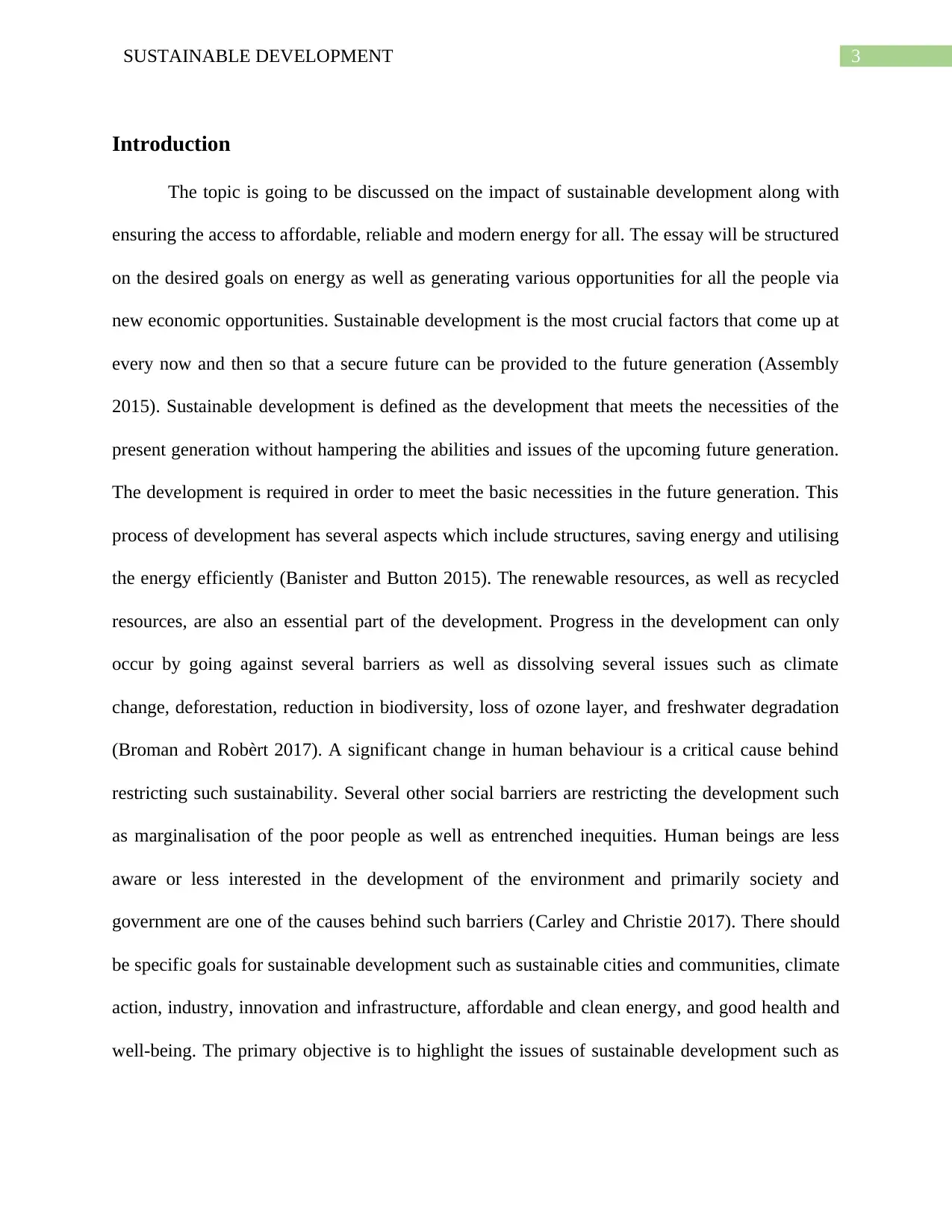
3SUSTAINABLE DEVELOPMENT
Introduction
The topic is going to be discussed on the impact of sustainable development along with
ensuring the access to affordable, reliable and modern energy for all. The essay will be structured
on the desired goals on energy as well as generating various opportunities for all the people via
new economic opportunities. Sustainable development is the most crucial factors that come up at
every now and then so that a secure future can be provided to the future generation (Assembly
2015). Sustainable development is defined as the development that meets the necessities of the
present generation without hampering the abilities and issues of the upcoming future generation.
The development is required in order to meet the basic necessities in the future generation. This
process of development has several aspects which include structures, saving energy and utilising
the energy efficiently (Banister and Button 2015). The renewable resources, as well as recycled
resources, are also an essential part of the development. Progress in the development can only
occur by going against several barriers as well as dissolving several issues such as climate
change, deforestation, reduction in biodiversity, loss of ozone layer, and freshwater degradation
(Broman and Robèrt 2017). A significant change in human behaviour is a critical cause behind
restricting such sustainability. Several other social barriers are restricting the development such
as marginalisation of the poor people as well as entrenched inequities. Human beings are less
aware or less interested in the development of the environment and primarily society and
government are one of the causes behind such barriers (Carley and Christie 2017). There should
be specific goals for sustainable development such as sustainable cities and communities, climate
action, industry, innovation and infrastructure, affordable and clean energy, and good health and
well-being. The primary objective is to highlight the issues of sustainable development such as
Introduction
The topic is going to be discussed on the impact of sustainable development along with
ensuring the access to affordable, reliable and modern energy for all. The essay will be structured
on the desired goals on energy as well as generating various opportunities for all the people via
new economic opportunities. Sustainable development is the most crucial factors that come up at
every now and then so that a secure future can be provided to the future generation (Assembly
2015). Sustainable development is defined as the development that meets the necessities of the
present generation without hampering the abilities and issues of the upcoming future generation.
The development is required in order to meet the basic necessities in the future generation. This
process of development has several aspects which include structures, saving energy and utilising
the energy efficiently (Banister and Button 2015). The renewable resources, as well as recycled
resources, are also an essential part of the development. Progress in the development can only
occur by going against several barriers as well as dissolving several issues such as climate
change, deforestation, reduction in biodiversity, loss of ozone layer, and freshwater degradation
(Broman and Robèrt 2017). A significant change in human behaviour is a critical cause behind
restricting such sustainability. Several other social barriers are restricting the development such
as marginalisation of the poor people as well as entrenched inequities. Human beings are less
aware or less interested in the development of the environment and primarily society and
government are one of the causes behind such barriers (Carley and Christie 2017). There should
be specific goals for sustainable development such as sustainable cities and communities, climate
action, industry, innovation and infrastructure, affordable and clean energy, and good health and
well-being. The primary objective is to highlight the issues of sustainable development such as
Paraphrase This Document
Need a fresh take? Get an instant paraphrase of this document with our AI Paraphraser
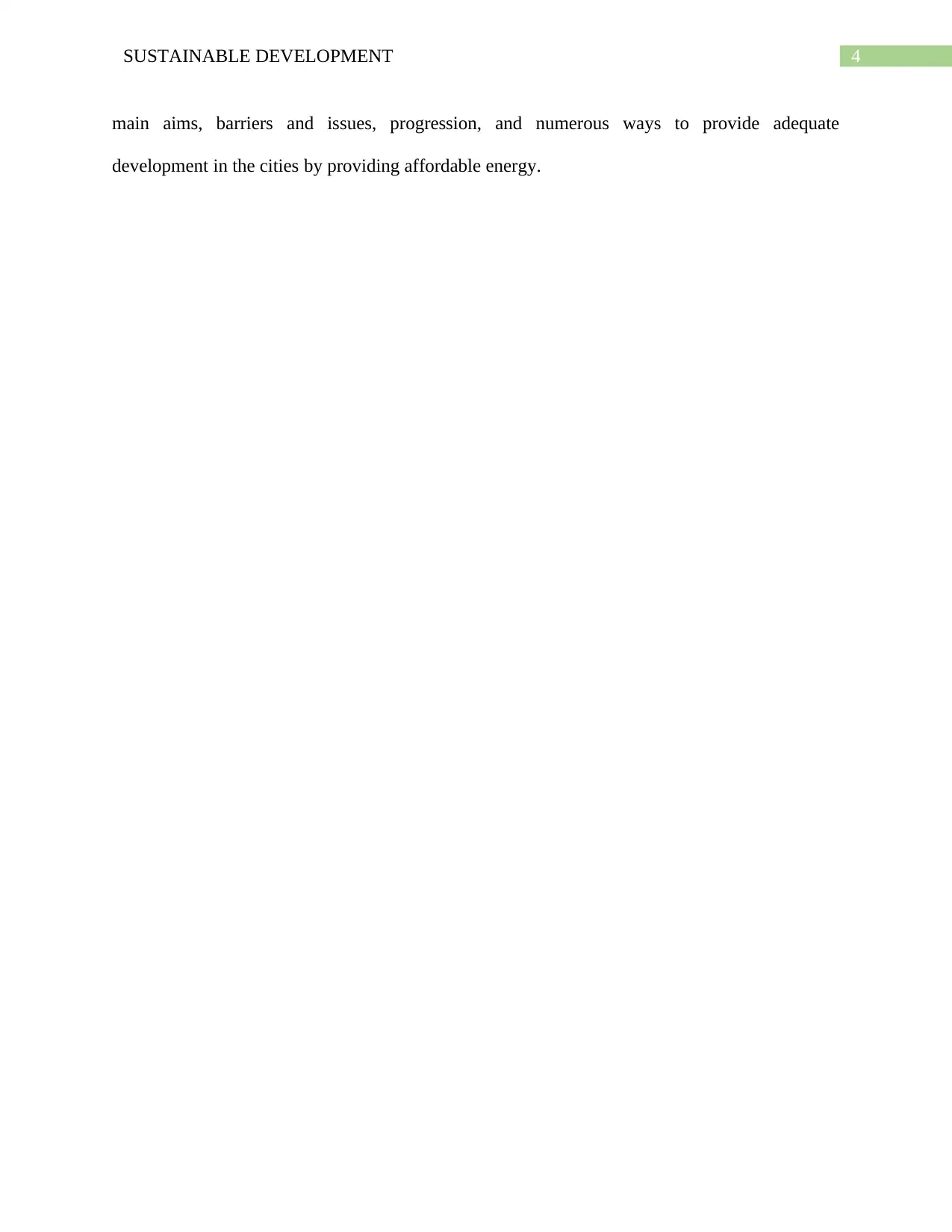
4SUSTAINABLE DEVELOPMENT
main aims, barriers and issues, progression, and numerous ways to provide adequate
development in the cities by providing affordable energy.
main aims, barriers and issues, progression, and numerous ways to provide adequate
development in the cities by providing affordable energy.
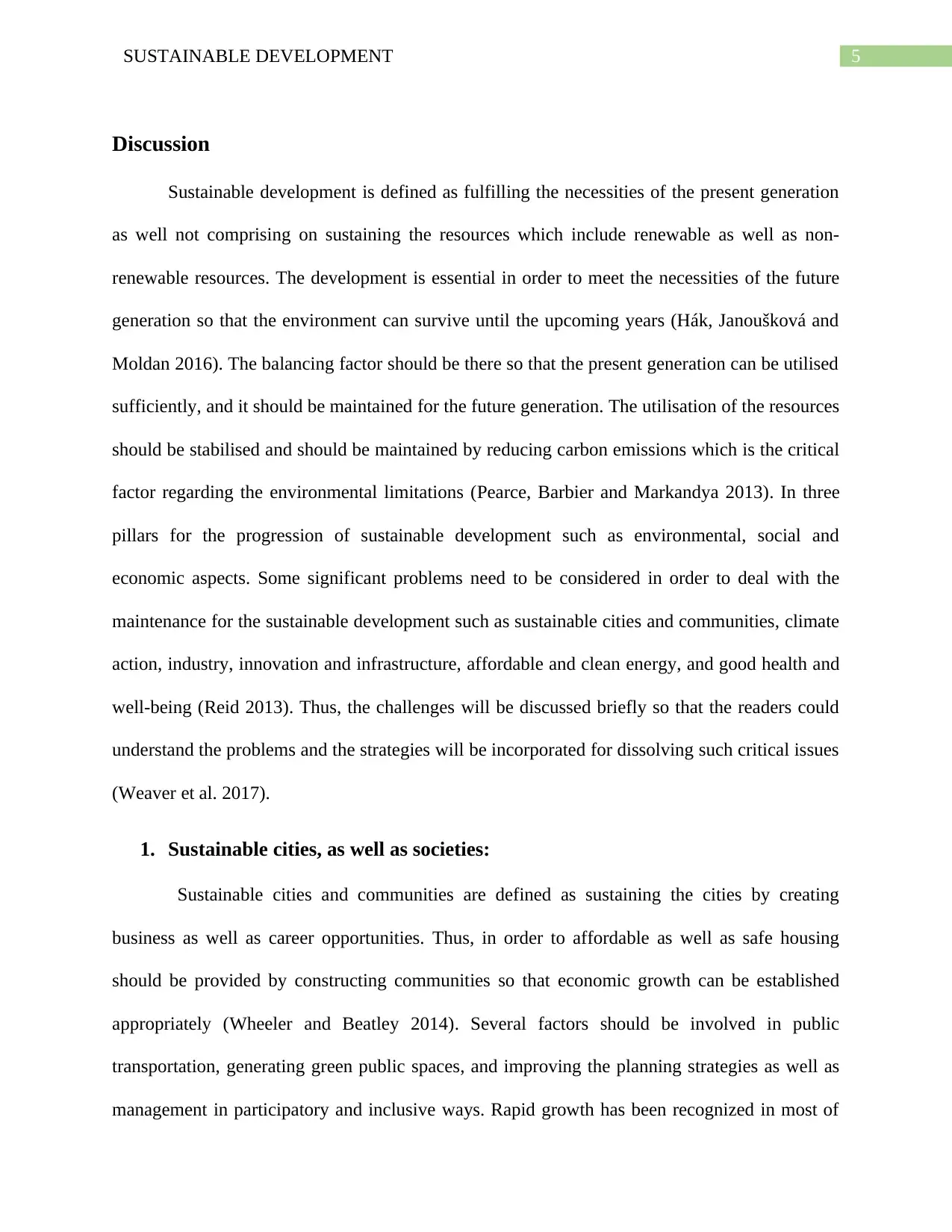
5SUSTAINABLE DEVELOPMENT
Discussion
Sustainable development is defined as fulfilling the necessities of the present generation
as well not comprising on sustaining the resources which include renewable as well as non-
renewable resources. The development is essential in order to meet the necessities of the future
generation so that the environment can survive until the upcoming years (Hák, Janoušková and
Moldan 2016). The balancing factor should be there so that the present generation can be utilised
sufficiently, and it should be maintained for the future generation. The utilisation of the resources
should be stabilised and should be maintained by reducing carbon emissions which is the critical
factor regarding the environmental limitations (Pearce, Barbier and Markandya 2013). In three
pillars for the progression of sustainable development such as environmental, social and
economic aspects. Some significant problems need to be considered in order to deal with the
maintenance for the sustainable development such as sustainable cities and communities, climate
action, industry, innovation and infrastructure, affordable and clean energy, and good health and
well-being (Reid 2013). Thus, the challenges will be discussed briefly so that the readers could
understand the problems and the strategies will be incorporated for dissolving such critical issues
(Weaver et al. 2017).
1. Sustainable cities, as well as societies:
Sustainable cities and communities are defined as sustaining the cities by creating
business as well as career opportunities. Thus, in order to affordable as well as safe housing
should be provided by constructing communities so that economic growth can be established
appropriately (Wheeler and Beatley 2014). Several factors should be involved in public
transportation, generating green public spaces, and improving the planning strategies as well as
management in participatory and inclusive ways. Rapid growth has been recognized in most of
Discussion
Sustainable development is defined as fulfilling the necessities of the present generation
as well not comprising on sustaining the resources which include renewable as well as non-
renewable resources. The development is essential in order to meet the necessities of the future
generation so that the environment can survive until the upcoming years (Hák, Janoušková and
Moldan 2016). The balancing factor should be there so that the present generation can be utilised
sufficiently, and it should be maintained for the future generation. The utilisation of the resources
should be stabilised and should be maintained by reducing carbon emissions which is the critical
factor regarding the environmental limitations (Pearce, Barbier and Markandya 2013). In three
pillars for the progression of sustainable development such as environmental, social and
economic aspects. Some significant problems need to be considered in order to deal with the
maintenance for the sustainable development such as sustainable cities and communities, climate
action, industry, innovation and infrastructure, affordable and clean energy, and good health and
well-being (Reid 2013). Thus, the challenges will be discussed briefly so that the readers could
understand the problems and the strategies will be incorporated for dissolving such critical issues
(Weaver et al. 2017).
1. Sustainable cities, as well as societies:
Sustainable cities and communities are defined as sustaining the cities by creating
business as well as career opportunities. Thus, in order to affordable as well as safe housing
should be provided by constructing communities so that economic growth can be established
appropriately (Wheeler and Beatley 2014). Several factors should be involved in public
transportation, generating green public spaces, and improving the planning strategies as well as
management in participatory and inclusive ways. Rapid growth has been recognized in most of
⊘ This is a preview!⊘
Do you want full access?
Subscribe today to unlock all pages.

Trusted by 1+ million students worldwide
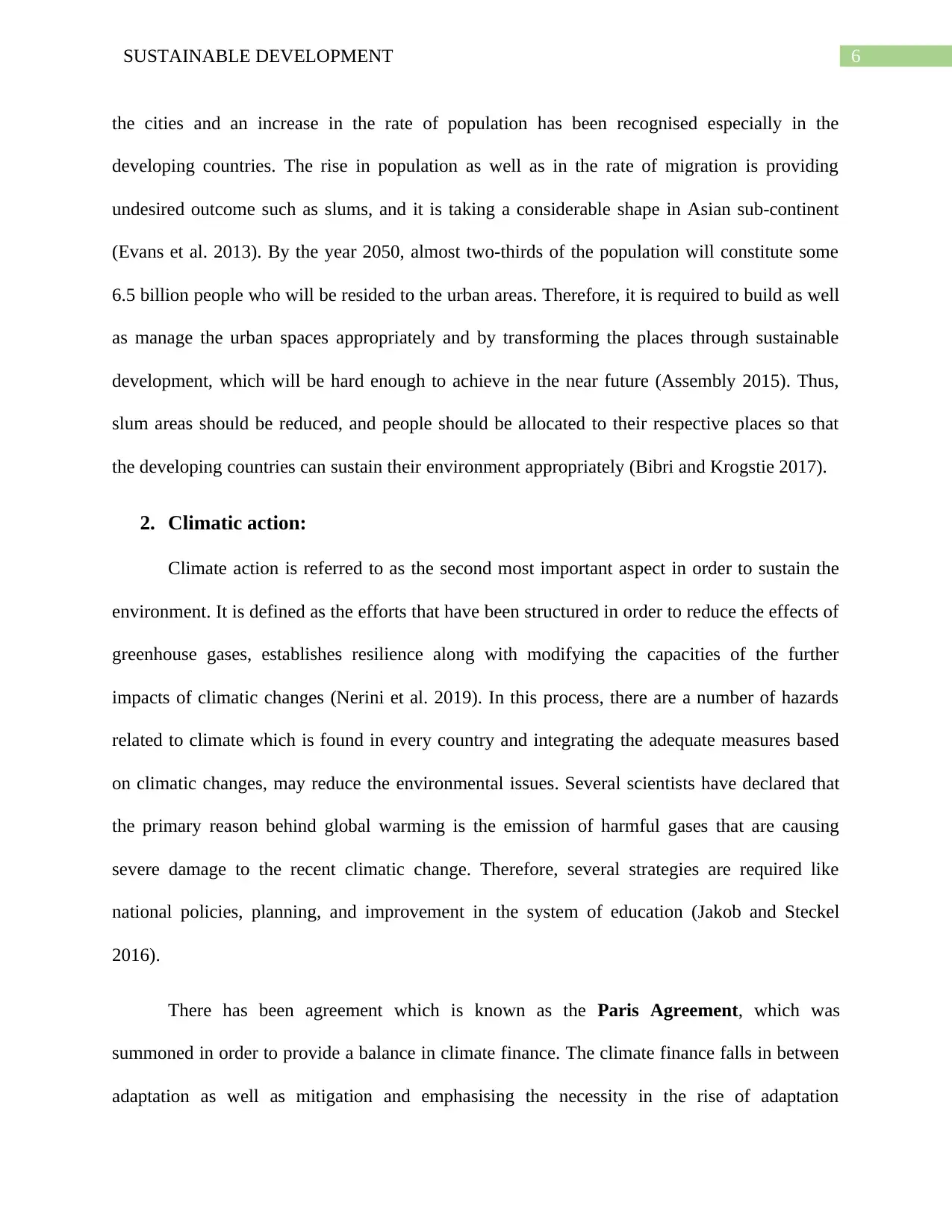
6SUSTAINABLE DEVELOPMENT
the cities and an increase in the rate of population has been recognised especially in the
developing countries. The rise in population as well as in the rate of migration is providing
undesired outcome such as slums, and it is taking a considerable shape in Asian sub-continent
(Evans et al. 2013). By the year 2050, almost two-thirds of the population will constitute some
6.5 billion people who will be resided to the urban areas. Therefore, it is required to build as well
as manage the urban spaces appropriately and by transforming the places through sustainable
development, which will be hard enough to achieve in the near future (Assembly 2015). Thus,
slum areas should be reduced, and people should be allocated to their respective places so that
the developing countries can sustain their environment appropriately (Bibri and Krogstie 2017).
2. Climatic action:
Climate action is referred to as the second most important aspect in order to sustain the
environment. It is defined as the efforts that have been structured in order to reduce the effects of
greenhouse gases, establishes resilience along with modifying the capacities of the further
impacts of climatic changes (Nerini et al. 2019). In this process, there are a number of hazards
related to climate which is found in every country and integrating the adequate measures based
on climatic changes, may reduce the environmental issues. Several scientists have declared that
the primary reason behind global warming is the emission of harmful gases that are causing
severe damage to the recent climatic change. Therefore, several strategies are required like
national policies, planning, and improvement in the system of education (Jakob and Steckel
2016).
There has been agreement which is known as the Paris Agreement, which was
summoned in order to provide a balance in climate finance. The climate finance falls in between
adaptation as well as mitigation and emphasising the necessity in the rise of adaptation
the cities and an increase in the rate of population has been recognised especially in the
developing countries. The rise in population as well as in the rate of migration is providing
undesired outcome such as slums, and it is taking a considerable shape in Asian sub-continent
(Evans et al. 2013). By the year 2050, almost two-thirds of the population will constitute some
6.5 billion people who will be resided to the urban areas. Therefore, it is required to build as well
as manage the urban spaces appropriately and by transforming the places through sustainable
development, which will be hard enough to achieve in the near future (Assembly 2015). Thus,
slum areas should be reduced, and people should be allocated to their respective places so that
the developing countries can sustain their environment appropriately (Bibri and Krogstie 2017).
2. Climatic action:
Climate action is referred to as the second most important aspect in order to sustain the
environment. It is defined as the efforts that have been structured in order to reduce the effects of
greenhouse gases, establishes resilience along with modifying the capacities of the further
impacts of climatic changes (Nerini et al. 2019). In this process, there are a number of hazards
related to climate which is found in every country and integrating the adequate measures based
on climatic changes, may reduce the environmental issues. Several scientists have declared that
the primary reason behind global warming is the emission of harmful gases that are causing
severe damage to the recent climatic change. Therefore, several strategies are required like
national policies, planning, and improvement in the system of education (Jakob and Steckel
2016).
There has been agreement which is known as the Paris Agreement, which was
summoned in order to provide a balance in climate finance. The climate finance falls in between
adaptation as well as mitigation and emphasising the necessity in the rise of adaptation
Paraphrase This Document
Need a fresh take? Get an instant paraphrase of this document with our AI Paraphraser
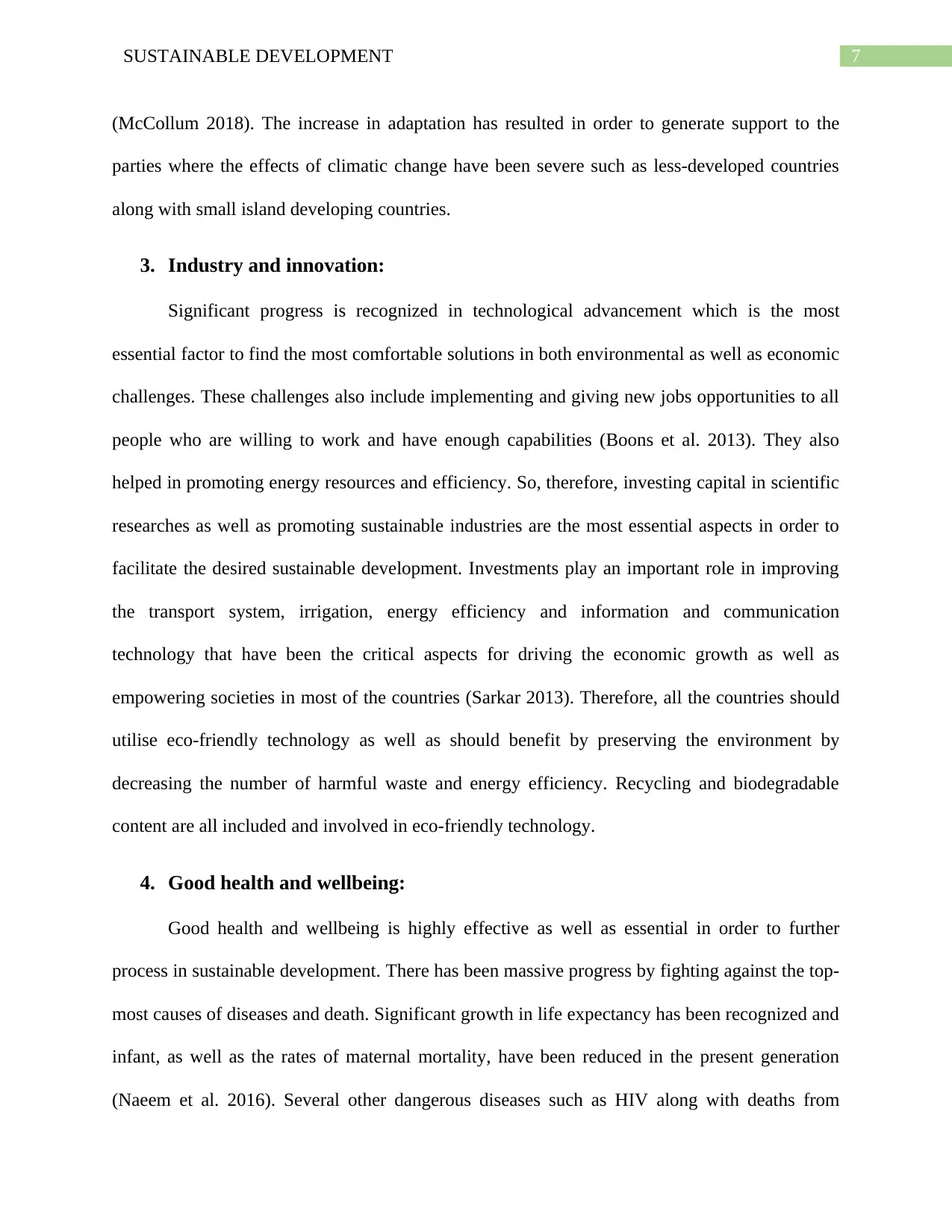
7SUSTAINABLE DEVELOPMENT
(McCollum 2018). The increase in adaptation has resulted in order to generate support to the
parties where the effects of climatic change have been severe such as less-developed countries
along with small island developing countries.
3. Industry and innovation:
Significant progress is recognized in technological advancement which is the most
essential factor to find the most comfortable solutions in both environmental as well as economic
challenges. These challenges also include implementing and giving new jobs opportunities to all
people who are willing to work and have enough capabilities (Boons et al. 2013). They also
helped in promoting energy resources and efficiency. So, therefore, investing capital in scientific
researches as well as promoting sustainable industries are the most essential aspects in order to
facilitate the desired sustainable development. Investments play an important role in improving
the transport system, irrigation, energy efficiency and information and communication
technology that have been the critical aspects for driving the economic growth as well as
empowering societies in most of the countries (Sarkar 2013). Therefore, all the countries should
utilise eco-friendly technology as well as should benefit by preserving the environment by
decreasing the number of harmful waste and energy efficiency. Recycling and biodegradable
content are all included and involved in eco-friendly technology.
4. Good health and wellbeing:
Good health and wellbeing is highly effective as well as essential in order to further
process in sustainable development. There has been massive progress by fighting against the top-
most causes of diseases and death. Significant growth in life expectancy has been recognized and
infant, as well as the rates of maternal mortality, have been reduced in the present generation
(Naeem et al. 2016). Several other dangerous diseases such as HIV along with deaths from
(McCollum 2018). The increase in adaptation has resulted in order to generate support to the
parties where the effects of climatic change have been severe such as less-developed countries
along with small island developing countries.
3. Industry and innovation:
Significant progress is recognized in technological advancement which is the most
essential factor to find the most comfortable solutions in both environmental as well as economic
challenges. These challenges also include implementing and giving new jobs opportunities to all
people who are willing to work and have enough capabilities (Boons et al. 2013). They also
helped in promoting energy resources and efficiency. So, therefore, investing capital in scientific
researches as well as promoting sustainable industries are the most essential aspects in order to
facilitate the desired sustainable development. Investments play an important role in improving
the transport system, irrigation, energy efficiency and information and communication
technology that have been the critical aspects for driving the economic growth as well as
empowering societies in most of the countries (Sarkar 2013). Therefore, all the countries should
utilise eco-friendly technology as well as should benefit by preserving the environment by
decreasing the number of harmful waste and energy efficiency. Recycling and biodegradable
content are all included and involved in eco-friendly technology.
4. Good health and wellbeing:
Good health and wellbeing is highly effective as well as essential in order to further
process in sustainable development. There has been massive progress by fighting against the top-
most causes of diseases and death. Significant growth in life expectancy has been recognized and
infant, as well as the rates of maternal mortality, have been reduced in the present generation
(Naeem et al. 2016). Several other dangerous diseases such as HIV along with deaths from
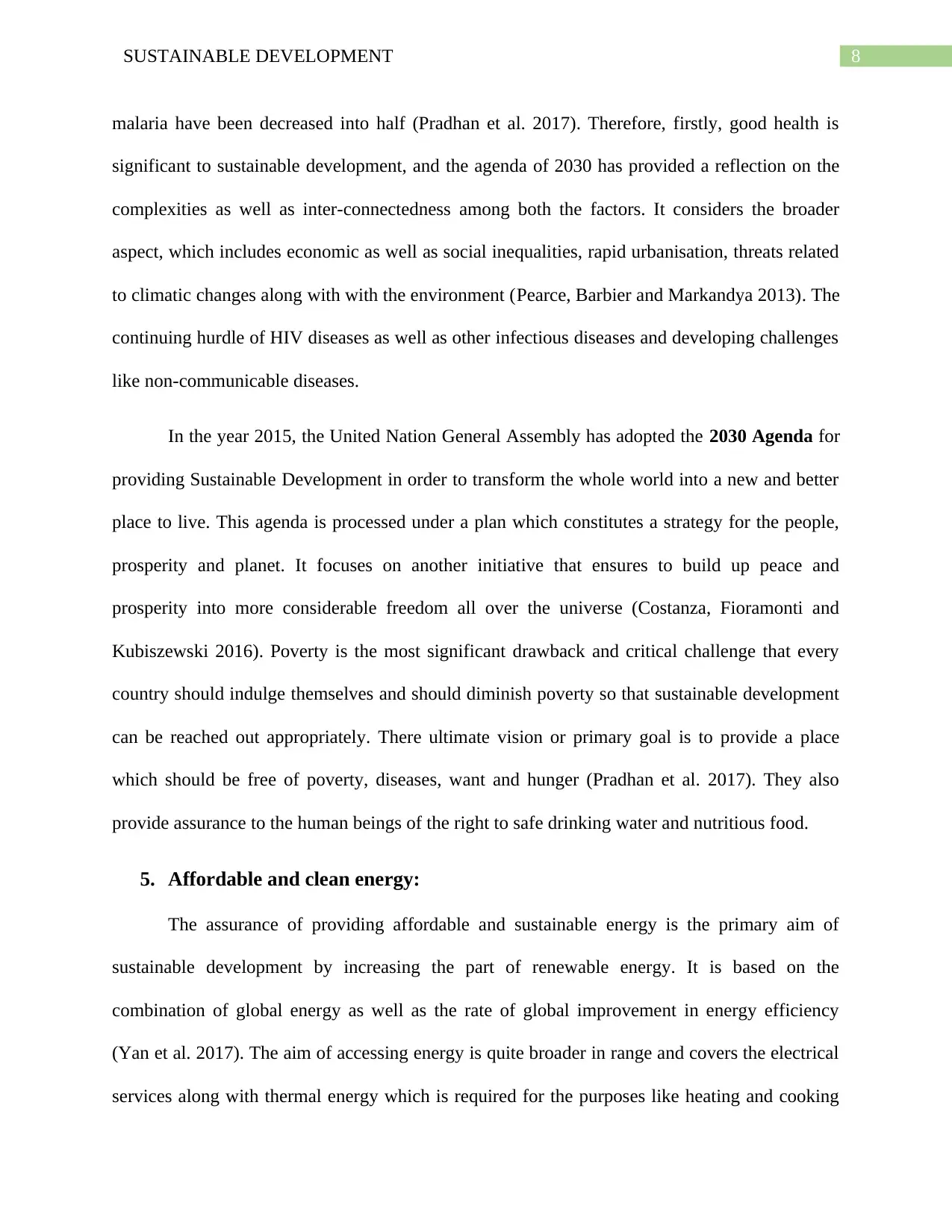
8SUSTAINABLE DEVELOPMENT
malaria have been decreased into half (Pradhan et al. 2017). Therefore, firstly, good health is
significant to sustainable development, and the agenda of 2030 has provided a reflection on the
complexities as well as inter-connectedness among both the factors. It considers the broader
aspect, which includes economic as well as social inequalities, rapid urbanisation, threats related
to climatic changes along with with the environment (Pearce, Barbier and Markandya 2013). The
continuing hurdle of HIV diseases as well as other infectious diseases and developing challenges
like non-communicable diseases.
In the year 2015, the United Nation General Assembly has adopted the 2030 Agenda for
providing Sustainable Development in order to transform the whole world into a new and better
place to live. This agenda is processed under a plan which constitutes a strategy for the people,
prosperity and planet. It focuses on another initiative that ensures to build up peace and
prosperity into more considerable freedom all over the universe (Costanza, Fioramonti and
Kubiszewski 2016). Poverty is the most significant drawback and critical challenge that every
country should indulge themselves and should diminish poverty so that sustainable development
can be reached out appropriately. There ultimate vision or primary goal is to provide a place
which should be free of poverty, diseases, want and hunger (Pradhan et al. 2017). They also
provide assurance to the human beings of the right to safe drinking water and nutritious food.
5. Affordable and clean energy:
The assurance of providing affordable and sustainable energy is the primary aim of
sustainable development by increasing the part of renewable energy. It is based on the
combination of global energy as well as the rate of global improvement in energy efficiency
(Yan et al. 2017). The aim of accessing energy is quite broader in range and covers the electrical
services along with thermal energy which is required for the purposes like heating and cooking
malaria have been decreased into half (Pradhan et al. 2017). Therefore, firstly, good health is
significant to sustainable development, and the agenda of 2030 has provided a reflection on the
complexities as well as inter-connectedness among both the factors. It considers the broader
aspect, which includes economic as well as social inequalities, rapid urbanisation, threats related
to climatic changes along with with the environment (Pearce, Barbier and Markandya 2013). The
continuing hurdle of HIV diseases as well as other infectious diseases and developing challenges
like non-communicable diseases.
In the year 2015, the United Nation General Assembly has adopted the 2030 Agenda for
providing Sustainable Development in order to transform the whole world into a new and better
place to live. This agenda is processed under a plan which constitutes a strategy for the people,
prosperity and planet. It focuses on another initiative that ensures to build up peace and
prosperity into more considerable freedom all over the universe (Costanza, Fioramonti and
Kubiszewski 2016). Poverty is the most significant drawback and critical challenge that every
country should indulge themselves and should diminish poverty so that sustainable development
can be reached out appropriately. There ultimate vision or primary goal is to provide a place
which should be free of poverty, diseases, want and hunger (Pradhan et al. 2017). They also
provide assurance to the human beings of the right to safe drinking water and nutritious food.
5. Affordable and clean energy:
The assurance of providing affordable and sustainable energy is the primary aim of
sustainable development by increasing the part of renewable energy. It is based on the
combination of global energy as well as the rate of global improvement in energy efficiency
(Yan et al. 2017). The aim of accessing energy is quite broader in range and covers the electrical
services along with thermal energy which is required for the purposes like heating and cooking
⊘ This is a preview!⊘
Do you want full access?
Subscribe today to unlock all pages.

Trusted by 1+ million students worldwide
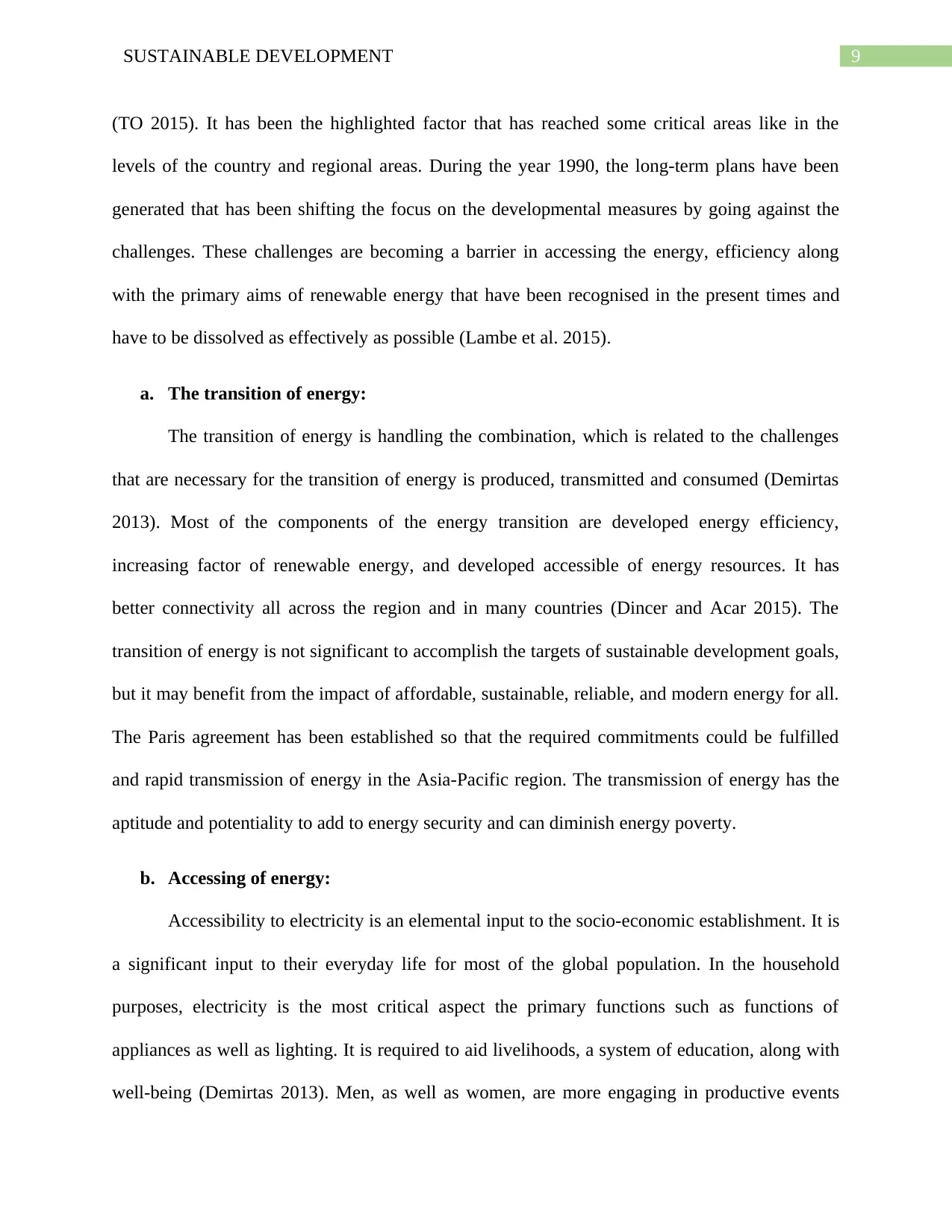
9SUSTAINABLE DEVELOPMENT
(TO 2015). It has been the highlighted factor that has reached some critical areas like in the
levels of the country and regional areas. During the year 1990, the long-term plans have been
generated that has been shifting the focus on the developmental measures by going against the
challenges. These challenges are becoming a barrier in accessing the energy, efficiency along
with the primary aims of renewable energy that have been recognised in the present times and
have to be dissolved as effectively as possible (Lambe et al. 2015).
a. The transition of energy:
The transition of energy is handling the combination, which is related to the challenges
that are necessary for the transition of energy is produced, transmitted and consumed (Demirtas
2013). Most of the components of the energy transition are developed energy efficiency,
increasing factor of renewable energy, and developed accessible of energy resources. It has
better connectivity all across the region and in many countries (Dincer and Acar 2015). The
transition of energy is not significant to accomplish the targets of sustainable development goals,
but it may benefit from the impact of affordable, sustainable, reliable, and modern energy for all.
The Paris agreement has been established so that the required commitments could be fulfilled
and rapid transmission of energy in the Asia-Pacific region. The transmission of energy has the
aptitude and potentiality to add to energy security and can diminish energy poverty.
b. Accessing of energy:
Accessibility to electricity is an elemental input to the socio-economic establishment. It is
a significant input to their everyday life for most of the global population. In the household
purposes, electricity is the most critical aspect the primary functions such as functions of
appliances as well as lighting. It is required to aid livelihoods, a system of education, along with
well-being (Demirtas 2013). Men, as well as women, are more engaging in productive events
(TO 2015). It has been the highlighted factor that has reached some critical areas like in the
levels of the country and regional areas. During the year 1990, the long-term plans have been
generated that has been shifting the focus on the developmental measures by going against the
challenges. These challenges are becoming a barrier in accessing the energy, efficiency along
with the primary aims of renewable energy that have been recognised in the present times and
have to be dissolved as effectively as possible (Lambe et al. 2015).
a. The transition of energy:
The transition of energy is handling the combination, which is related to the challenges
that are necessary for the transition of energy is produced, transmitted and consumed (Demirtas
2013). Most of the components of the energy transition are developed energy efficiency,
increasing factor of renewable energy, and developed accessible of energy resources. It has
better connectivity all across the region and in many countries (Dincer and Acar 2015). The
transition of energy is not significant to accomplish the targets of sustainable development goals,
but it may benefit from the impact of affordable, sustainable, reliable, and modern energy for all.
The Paris agreement has been established so that the required commitments could be fulfilled
and rapid transmission of energy in the Asia-Pacific region. The transmission of energy has the
aptitude and potentiality to add to energy security and can diminish energy poverty.
b. Accessing of energy:
Accessibility to electricity is an elemental input to the socio-economic establishment. It is
a significant input to their everyday life for most of the global population. In the household
purposes, electricity is the most critical aspect the primary functions such as functions of
appliances as well as lighting. It is required to aid livelihoods, a system of education, along with
well-being (Demirtas 2013). Men, as well as women, are more engaging in productive events
Paraphrase This Document
Need a fresh take? Get an instant paraphrase of this document with our AI Paraphraser
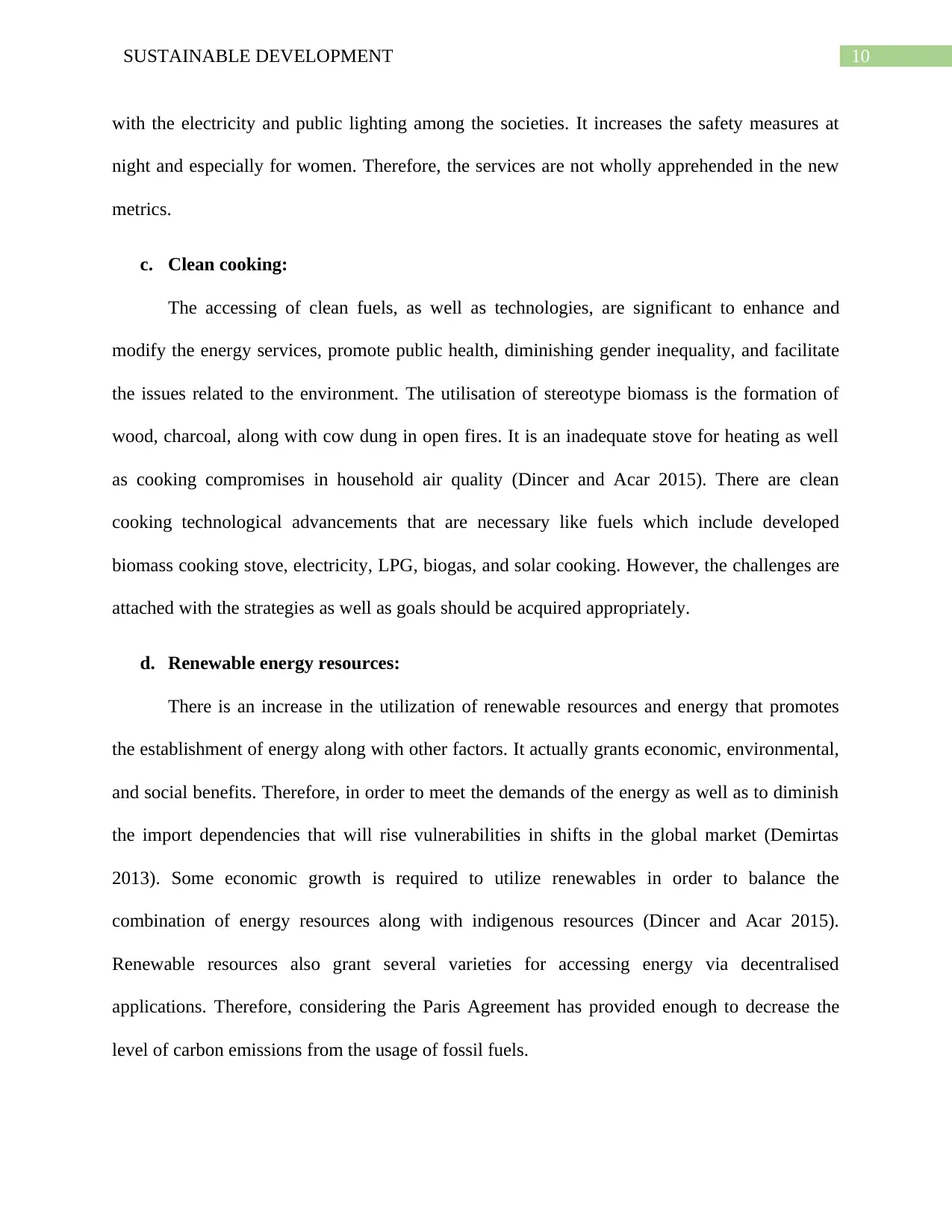
10SUSTAINABLE DEVELOPMENT
with the electricity and public lighting among the societies. It increases the safety measures at
night and especially for women. Therefore, the services are not wholly apprehended in the new
metrics.
c. Clean cooking:
The accessing of clean fuels, as well as technologies, are significant to enhance and
modify the energy services, promote public health, diminishing gender inequality, and facilitate
the issues related to the environment. The utilisation of stereotype biomass is the formation of
wood, charcoal, along with cow dung in open fires. It is an inadequate stove for heating as well
as cooking compromises in household air quality (Dincer and Acar 2015). There are clean
cooking technological advancements that are necessary like fuels which include developed
biomass cooking stove, electricity, LPG, biogas, and solar cooking. However, the challenges are
attached with the strategies as well as goals should be acquired appropriately.
d. Renewable energy resources:
There is an increase in the utilization of renewable resources and energy that promotes
the establishment of energy along with other factors. It actually grants economic, environmental,
and social benefits. Therefore, in order to meet the demands of the energy as well as to diminish
the import dependencies that will rise vulnerabilities in shifts in the global market (Demirtas
2013). Some economic growth is required to utilize renewables in order to balance the
combination of energy resources along with indigenous resources (Dincer and Acar 2015).
Renewable resources also grant several varieties for accessing energy via decentralised
applications. Therefore, considering the Paris Agreement has provided enough to decrease the
level of carbon emissions from the usage of fossil fuels.
with the electricity and public lighting among the societies. It increases the safety measures at
night and especially for women. Therefore, the services are not wholly apprehended in the new
metrics.
c. Clean cooking:
The accessing of clean fuels, as well as technologies, are significant to enhance and
modify the energy services, promote public health, diminishing gender inequality, and facilitate
the issues related to the environment. The utilisation of stereotype biomass is the formation of
wood, charcoal, along with cow dung in open fires. It is an inadequate stove for heating as well
as cooking compromises in household air quality (Dincer and Acar 2015). There are clean
cooking technological advancements that are necessary like fuels which include developed
biomass cooking stove, electricity, LPG, biogas, and solar cooking. However, the challenges are
attached with the strategies as well as goals should be acquired appropriately.
d. Renewable energy resources:
There is an increase in the utilization of renewable resources and energy that promotes
the establishment of energy along with other factors. It actually grants economic, environmental,
and social benefits. Therefore, in order to meet the demands of the energy as well as to diminish
the import dependencies that will rise vulnerabilities in shifts in the global market (Demirtas
2013). Some economic growth is required to utilize renewables in order to balance the
combination of energy resources along with indigenous resources (Dincer and Acar 2015).
Renewable resources also grant several varieties for accessing energy via decentralised
applications. Therefore, considering the Paris Agreement has provided enough to decrease the
level of carbon emissions from the usage of fossil fuels.
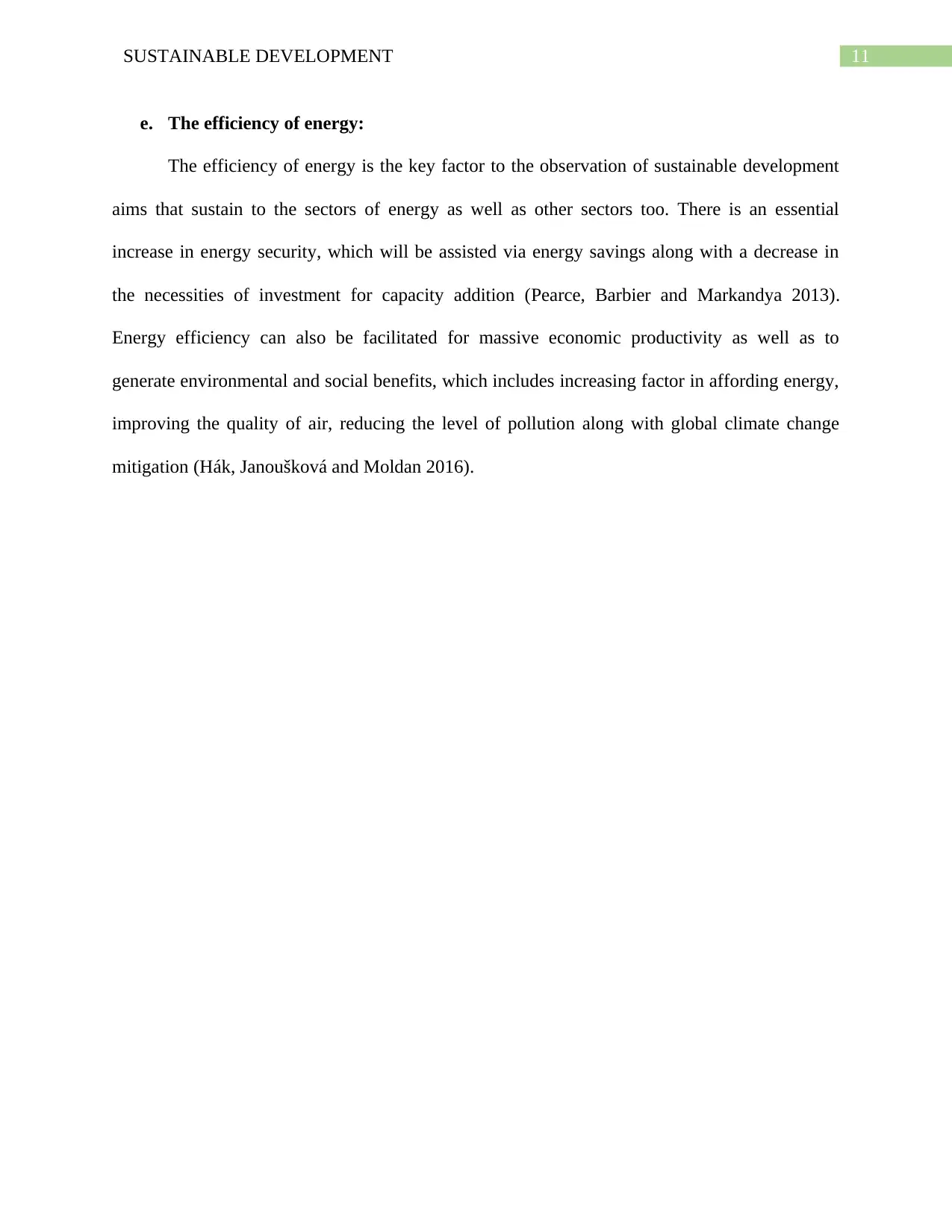
11SUSTAINABLE DEVELOPMENT
e. The efficiency of energy:
The efficiency of energy is the key factor to the observation of sustainable development
aims that sustain to the sectors of energy as well as other sectors too. There is an essential
increase in energy security, which will be assisted via energy savings along with a decrease in
the necessities of investment for capacity addition (Pearce, Barbier and Markandya 2013).
Energy efficiency can also be facilitated for massive economic productivity as well as to
generate environmental and social benefits, which includes increasing factor in affording energy,
improving the quality of air, reducing the level of pollution along with global climate change
mitigation (Hák, Janoušková and Moldan 2016).
e. The efficiency of energy:
The efficiency of energy is the key factor to the observation of sustainable development
aims that sustain to the sectors of energy as well as other sectors too. There is an essential
increase in energy security, which will be assisted via energy savings along with a decrease in
the necessities of investment for capacity addition (Pearce, Barbier and Markandya 2013).
Energy efficiency can also be facilitated for massive economic productivity as well as to
generate environmental and social benefits, which includes increasing factor in affording energy,
improving the quality of air, reducing the level of pollution along with global climate change
mitigation (Hák, Janoušková and Moldan 2016).
⊘ This is a preview!⊘
Do you want full access?
Subscribe today to unlock all pages.

Trusted by 1+ million students worldwide
1 out of 16
Related Documents
Your All-in-One AI-Powered Toolkit for Academic Success.
+13062052269
info@desklib.com
Available 24*7 on WhatsApp / Email
![[object Object]](/_next/static/media/star-bottom.7253800d.svg)
Unlock your academic potential
Copyright © 2020–2025 A2Z Services. All Rights Reserved. Developed and managed by ZUCOL.




